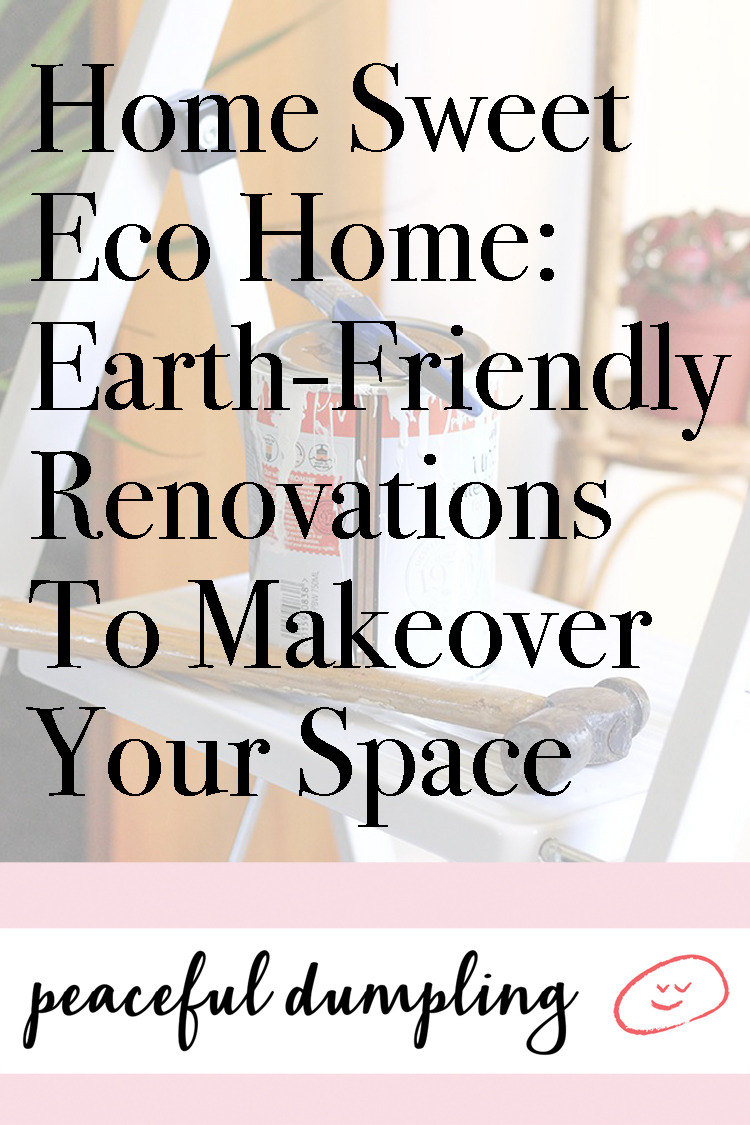This article was originally published on March 23, 2018.
Spring is here and your fingers are itching to get to work on some home renovations. That’s great! Our space totally influences our state of mind and taking some steps to improve it can open many new doors for us. But what about if one of your values right now is trying to live sustainably? Can the two go hand-in-hand? The answer is yes! From a fresh coat of paint to a new vanity, here’s what you need to consider if you’re looking to give your home a makeover.

Starting out with one of the most dramatic ways that you can change a room, cue: a coat of color. Have you ever been in the undesirable situation where a day of painting has rendered you full of headache and slightly nauseous? There’s a reason for that: the formaldehyde and Volatile Organic Compounds (VOCs). Not to mention the heavy metals in traditional formulas. Formaldehyde is a known carcinogen and one of those nasty ingredients culled from nail polish brands trying to do the ‘5-‘ or ‘7-free’ formula-type-thing. And the VOCs? They are skin-irritants, headache-inducers and all round anti-feelgood. Not to mention the fact that the widespread use of VOCs in things like paint (and conventional cleaning products!) is thought to be one of the major sources of urban air pollution alongside fuel emissions.
But, there is good news. The demand is growing for eco-friendly alternatives to these harmful formulas. The ideal is plant-based, water-borne paints, with plant-based, solvent-borne (derived from natural solvents) coming in second place. German brand, Aglaia, is leading the way with formulas that are 100% natural! UK brand, Lakeland, is on a par and stateside, there’s Earthsafe Finishes and AFM Safecoat who are striving for ‘cleaner’ formulas.
Painting done, perhaps you’re now thinking about introducing a new piece of furniture? The very best thing that you can do is to purchase secondhand. Antiques especially are always excellent conversation-starters and help mold your home into a space that’s entirely unique. But if antiques aren’t your style, or you can’t get a hold of anything you like, then the next best option is to consider reclaimed timber. Find an excellent carpenter who can make you a custom piece using reclaimed resources.
The biggest concerns with new wooden furniture is either the demand for hardwoods and the deforestation that results, or the health implication of using things like MDF and plywood. These cheaper woods are not solid, but instead chip wood or wood in thin sheets joined together by harsh, formaldehyde-containing glues. These fumes are actually emitted into the air over time and, unfortunately, inhaled.
But, before you panic and throw your TV stand out the window and into the road, there is something you can do: add plants! Many houseplants are great at filtering indoor air and reducing nasty compounds you’d rather not have circulating, with snake plants, English ivy, and Aloe vera coming out on top. Kill two birds with one stone (what an un-vegan saying, I’ve just come to realize) by adding plants that clean up the air while adding some extra character to your home.

Moving swiftly on to one of the easiest ways to update your home and especially useful if you live in rented accommodation: soft furnishings. Your rugs, curtains, throw pillows and bedding can all add color, pattern, and texture that quickly revamp simple surroundings and help generate the cozy factor. But do you stop to consider the mastery behind those items, or what was involved during the various stages that transformed raw material into a finished item?
As with any other purchase, the most ethical option is to purchase secondhand, pre-loved items where possible. Give them a good clean following proper procedures and watch them sparkle like new. But if you can’t find what you’re after secondhand, or want to support a business striving to do good, then opt for natural fabrics that were grown organically and colored with natural pigments. And as for cushion filler? Opt for recycled polyester.
So, you’ve painted the walls, added in a new coffee table and perhaps a throw pillow or two. Are you good to go? Over time, as you long to change things up and add a fresh twist to your home, consider what you can upcycle each time, rather than buying new. It’s amazing how something as simple as painting the light fittings or sanding down and varnishing your cabinets can completely transform your home into something that looks entirely new. And most importantly, check you’re following the below whenever you’re planning on making a change:
H – Have I got something I already here that I can swap from another room and dye, paint or mold?
O – Is it organic? Is there a way I can reduce my chemical consumption?
M – What’s on the market? Have I done my research on the best brands/manufacturers?
E – Is it energy efficient? How can I maximize energy efficiency within my budget?

Are you due for a home renovation? What are your priorities for making it eco-friendly?
Also by Kat: Ugh! Air Pollution Hurts Mental Health. How To Protect Yourself Without Moving
Related: A Room-By-Room Guide To Green Your Entire Home & Save Major $$$
Cleaning With Essential Oils Is Sorta Life-Changing. 4 DIY Spray Recipes For Your Home
Get more like this—Subscribe to our daily inspirational newsletter for exclusive content!
—
Photos by Kat Kennedy
